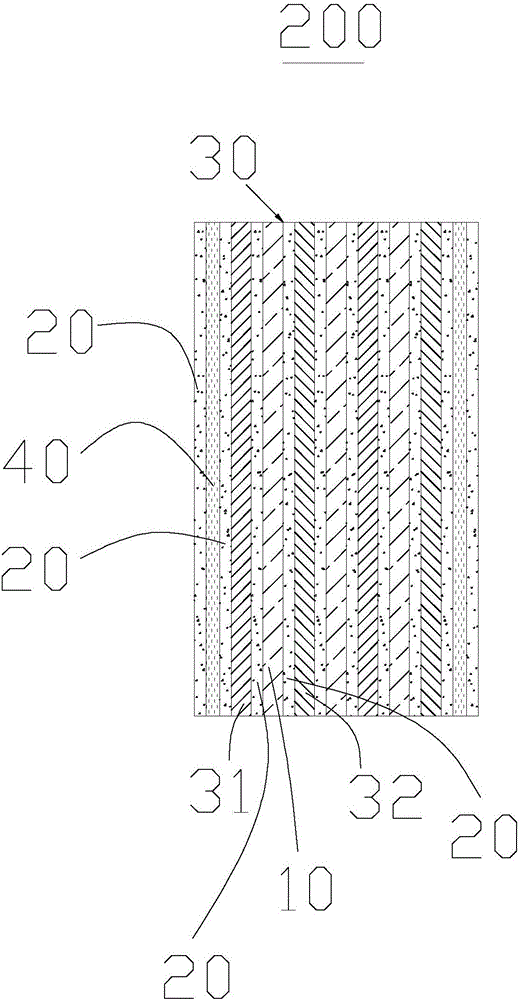Ceramic diaphragm, lithium ion battery and preparation methods for ceramic diaphragm and lithium ion battery
A lithium-ion battery and ceramic diaphragm technology, which is applied in the field of lithium-ion batteries, can solve the problems of no effective suppression of combustion, large battery volume expansion, and closed pores, so as to achieve the effect of improving life expectancy, safety, and safety performance
- Summary
- Abstract
- Description
- Claims
- Application Information
AI Technical Summary
Problems solved by technology
Method used
Image
Examples
Embodiment 1
[0056] 1. Negative electrode sheet preparation: use artificial graphite with a mass ratio of 96%, polyvinylidene fluoride and sodium carboxymethyl cellulose binder with a mass ratio of 2%, and 2% acetylene black as a conductive agent. With the same mass ratio of deionized water and styrene-butadiene rubber mixed solution, prepare the negative electrode sheet according to the general method in the industry;
[0057] 2. Weighing: take by weighing 50% triphenyl phosphate (boiling point 245 ° C, white crystals), 45% analytically pure nano-aluminum hydroxide (D 50 Particle size 4μm, specific surface area 5m 2 / g), the PVDF polyvinylidene fluoride (molecular weight 2,000,000 units) that mass ratio is 5%, joins in the stirred tank, takes by weighing and above-mentioned raw material (triphenyl phosphate, analytical pure nano aluminum hydroxide, polyvinylidene fluoride ) equal quality organic solvent NMP nitrogen methyl pyrrolidone, join in the above-mentioned stirred tank.
[0058] ...
Embodiment 2
[0063] The same steps as in Example 1 are used to prepare the slurry S2 and B2 for the ceramic diaphragm of the present example, the difference is that in step 2, the raw material is weighed: 50% cresyl diphenyl phosphate (boiling point : 255 ℃), mass ratio is 45% analytically pure nano-aluminum hydroxide, and mass ratio is 5% PVDF polyvinylidene fluoride, add in the stirred tank, take by weighing and above-mentioned raw material (diphenyl phosphoric acid, analytically pure nano-hydrogen Aluminum oxide, PVDF (polyvinylidene fluoride) equal quality organic solvent NMP nitrogen methyl pyrrolidone, join in the above-mentioned stirring tank.
Embodiment 3
[0065] The same steps as in Example 1 were used to prepare the slurries S3 and B3 for ceramic diaphragms of this example, the difference being that in step 2, the raw materials were weighed: 70% cresyl diphenyl phosphate was weighed, and the mass ratio was 70%. Ratio is 20% analytically pure nano-aluminum hydroxide, mass ratio is 10% PVDF polyvinylidene fluoride, add in the stirred tank, take by weighing and above-mentioned raw material (diphenyl phosphate cresyl ester, analytically pure nano-aluminum hydroxide, PVDF Polyvinylidene fluoride) equal quality organic solvent NMP nitrogen methyl pyrrolidone, join in the above-mentioned stirring tank.
PUM
| Property | Measurement | Unit |
|---|---|---|
| Thickness | aaaaa | aaaaa |
Abstract
Description
Claims
Application Information
 Login to View More
Login to View More - R&D
- Intellectual Property
- Life Sciences
- Materials
- Tech Scout
- Unparalleled Data Quality
- Higher Quality Content
- 60% Fewer Hallucinations
Browse by: Latest US Patents, China's latest patents, Technical Efficacy Thesaurus, Application Domain, Technology Topic, Popular Technical Reports.
© 2025 PatSnap. All rights reserved.Legal|Privacy policy|Modern Slavery Act Transparency Statement|Sitemap|About US| Contact US: help@patsnap.com



